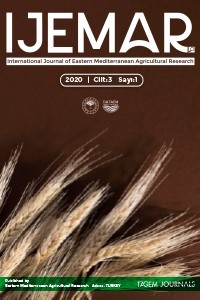Diyarbakır İli Hindi Yetiştiriciliğinin Yapısı
Hindi, kanatlı yetiştiriciliği
The Structure Of Turkey Breedıng Provınce Of Dıyarbakır
Turkey, poultry breeding,
___
- Aksoy, A., Yavuz, F., (2012). Çiftçilerin Küçükbaş Hayvan Yetiştiriciliğini Bırakma Nedenlerinin Analizi: Doğu Anadolu Bölgesi Örneği. Anadolu Tarım Bilim Dergisi. 27(2):76-79.
- BESD-BİR, (2013). Beyaz Et Sanayicileri ve Damızlıkçıları Birliği, Beyaz Etin Beslemede Yeri. (http://www.besd-bir.org)
- Denli, M., Sessiz, A., Tutkun, M. (2013). Diyarbakır İli Sığırcılık İşletmelerinin Genel Yapısal Durumu Ve Bakım-Beslenme Teknikleri Analizi Projesi. T.C Dicle Üniversitesi Ziraat Fakültesi Zootekni Bölümü Diyarbakır, 2013.
- Fulginiti, E.L. (1996). The change from red to white meat: The role of technology. Proceeding Book. AAEA Meetings, San Antonio, 1996.
- Güngördü, S. (2009). Batman İli Köy Tavukçuluğunun Durumu. Yüzüncü Yıl Üniversitesi Fen Bilimleri Enstitüsü Zootekni Anabilim Dalı (basılmamış tez)
- İnci, H. Taysı, R., M. Sevinç, E., H. (2013). Bingöl İlinde Hindi Yetiştiriciliğinin Mevcut Durumu ve Sorunları. Tr. Doğa ve Fen Dergisi. Tr. J. Nature Sci. 2013 Vol. 2 No. 1.
- Karakaya, E., Kızıloğlu, S. (2014). Küçükbaş Hayvancılık İşletmelerinin Örgütlenme Yapısı Bingöl İli Örneği. Türk Tarım ve Doğa Bilimleri Dergisi 1(4): 552–560, 2014.
- Konca, Y. (2001). Hindi Besiciliği. Tarımsal Araştırma ve Eğitim Koordinasyonu. (TAYEK/TYUAP) 2001 Yılı Hayvancılık Grubu Bilgi Alış Veriş Toplantısı Bildirileri. Ege Tarımsal Araştırma Enstitüsü Müdürlüğü, 27-29 Mart, İzmir, Yayın No: 100, Sayfa:21-31.
- Miran, B. (2003). Temel İstatistik. Ege Üniversitesi Basımevi, Bornova, İzmir.
- Sipahi, C. (2010). Entansif Hindi Yetiştiriciliği İşletmelerinde Kârlılık ve Verimlilik Analizleri. Hayvan Sağlığı Ekonomisi Ve İşletmeciliği Anabilim Dalı Doktora Tezi. Türkiye Cumhuriyeti. Ankara Üniversitesi. Sağlık Bilimleri Enstitüsü.
- SPSS, (2009). Statistical Package for the Social Sciences. SPSS for Windows Ver. 17.0, SPSS Inc., Chicago, Illinois, USA. Şekeroğlu, A., Akşimşek, D. Ş. (2009). Tokat İli Köy Tavukçuluğunun Bazı Özellikleri. Anadolu Tarım Bilim. Dergisi., 2009, 24: (2) :108-113 Anadolu J. Agric. Sci., 2009,24(2):108-113.
- Tan, S. Dellal, İ. (2002). Kırmızı Et Üretim ve Tüketim Açığını Kapatmak İçin Alternatif Bir Yaklaşım: Hindi Üretimi ve Sözleşmeli Yetiştiricilik Modeli. TEAE Yayınları No:85, Ankara, (2002).
- Yurt, Z. (2002). Çanakkale İlindeki Kimi Köylerde Köy Tipi Kümes Hayvanı Yetiştiriciliğinin İncelenmesi. (Yüksek Lisans Tezi). Çanakkale Onsekiz Mart Üniversitesi, Fen Bilimleri Enstitüsü, Zootekni Anabilim Dalı.
- ISSN: 2667-5102
- Yayın Aralığı: Yıllık
- Başlangıç: 2018
- Yayıncı: Eastern Mediterranean Agricultural Research Institute
Estimation of Some Quality Parameters of Durum Wheat with Near-Infrared Spectroscopy (NIRS)
Murat Reis AKKAYA, Ali Alpaslan EZİCİ, Osman KOLA, Hatice YÜCEL, Şadiye YAKTUBAY
Bazı Ayçiçeği Çeşitlerinin İn Vitro Gaz Üretim Tekniği Yardımıyla Besin Değerinin Tespiti
Tugay AYAŞAN, Abdullah ÇİL, Şerife ERGÜL, İsmail ÜLGER, Hakan İNCİ, Ayse Nuran ÇİL, Vakas ŞAHİN, Hacer BURUN, Celal KALEBAŞ
Buğday Tarımında Farklı Ekim Yöntemleri ve Sulamanın Teknik Yönden Karşılaştırılması
Hatun BARUT, Sait AYKANAT, Safiye AŞIKLI, Selim EKER
Soya Bitkisinin Hayvan Beslenmesindeki Yeri ve Önemi
Nurgül ERGİN, Serap KIZIL AYDEMİR
Diyarbakır İli Hindi Yetiştiriciliğinin Yapısı
Hakan İNCİ, Uğur KÜÇÜKBAYRAK, Ersin KARAKAYA, Ahmet AYDIN
Storage Methods of Minimal Processed Fruits and Vegetables
Arpada Toprak İşleme Tekniklerinin Verim ve Verim Öğelerine Etkisi
Ertan YAZGAN, Mustafa SAYGILI, Bilal ÇOKAKLI
Su Ürünleri İşleme Teknolojisinde Kullanımı Yasal Olan Gıda Katkı Maddelerinin Değerlendirilmesi
